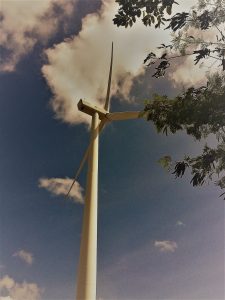When travelers speak of Guimaras, they usually become chatty about mangoes, local farm products, and highlight the experiences that they have gathered of its rocky coastlines and the crystal-clear waters of its beaches and hidden islets.
But a closer look on the island’s spots has revealed a facet that energized tourism – the 54 megawatts wind farm project in San Lorenzo town operated by PHINMA Renewable Energy Corp., a subsidiary of PHINMA Energy.
The P6.7-billion project by the Philippine Investment Management, Inc. (PHINMA) has been described by plant manager Engr. Edwin Gallego as the bright spot of Guimaras which enhanced tourism experience of visitors to the island.
The 27 turbines can produce 2-MW each of wind power. It can generate more than 70 percent of its annual target output during the high wind months from October to May.
Unlike in Bangui Bay in Ilocos Norte wherein wind turbines are lined up at the coastline, turbines are scattered across four villages of Cabungahan, M. Chavez, Cabano and Suclaran yet strategically positioned based from micro-sightings and wind speed studies.
Developed from Spanish technology, PHINMA’s wind farm received an influx of visitors coming from different cities in the Philippines who were visiting Guimaras for the 25th Manggahan Festival.
A family from Cebu who traveled by van on a roll-on-roll-off explored Guimaras island with the wind farm as its first stop among listed destinations on the map that they were holding. They have joined with scores more who were already on the visitor’s deck taking selfies and group photos for posting to social media accounts.
Increased visitors annually
“We are receiving thousands of visitors each year since we started full operations on December 27, 2014, explained Engr. Gallego, and “most of the visitors inquired about wind technology for power generation.”
In 2016, the wind farm had received 31,983 visitors. It increased to 55,137 in 2017. The high wind month of May had the highest number of visitors recorded at 8,740 that year.
From January to April this year, visitors have already totaled to 26,968 yet the plant manager quipped that “they are anticipating more visitors to come for the rest of the year.”
In 2017, a huge share of 97 percent from a total tourist arrival of 128,256 recorded for Guimaras by the Dept. of Tourism-VI were domestic visitors. Only 3 percent were foreign tourists who visited the island last year.
For Engr. Gallego, Guimaras is an attractive tourist destination given its natural beauty and because of many new resorts that opened in the last 5 years and underscored improved road infrastructure.
The wind power player also integrated around 14 kilometers of road construction and widening as part of its project development benefitting communities within the project site.
Additional wind farm to rise in the island
The PHINMA San Lorenzo wind farm intends to generate a total of 102-million kWh for 2018.
But the renewable energy outfit is investing P5-billion more for another 40-MW wind farm in the neighboring town of Sibunag starting 2019.
 Composed of 17 wind turbines, each unit will be bigger both in terms of size and capacity for it can produce 3.2-MW of wind power. Upon completion of the project, Guimaras will have a total infusion of 92-MW wind power to the Visayas power grid.
Composed of 17 wind turbines, each unit will be bigger both in terms of size and capacity for it can produce 3.2-MW of wind power. Upon completion of the project, Guimaras will have a total infusion of 92-MW wind power to the Visayas power grid.
In the 2017 power statistics from the Dept. of Energy, wind power generation totaled to 1,094-GWh. Although it has a total installed generating capacity of 427-MW, wind power’s total dependable capacity was only 383-MW.
Yet the new investment by PHINMA will bring increased capacity from wind power to the Philippine energy mix beyond 2020 and will further boost the status of Guimaras, not only as an eco-tourism spot but this time as a major wind power and renewable energy tourist destination.
What attracts tourists to the wind farm?
What magnetizes tourists to visit the PHINMA wind farm is curiosity and new technology.
“What makes the wind farm a peculiar tourist destination is the interest of people to find answers on what this (wind farm) is all about and how it works,” stressed Engr. Gallego, and “so we take time to explain to them and to interact with visitors.”
Moreover, “we don’t see a wind farm every day or in our neighborhood for it is site-specific, so it creates curiosity,” Engr. Gallego pointed out.
By going closer to the turbine, tourists will be in awe by its massive size. It majestically stands at 123 meters tall having a 45 meters blade length held by a 78 meters tower.
The wind turbine in Guimaras is also a by-product of long technological development.
The first windmill for electricity production was first developed by Professor James Blyth of Anderson’s College in Glasgow, Scotland. After experimenting with three turbine designs, Blyth picked the third design which he used to power his home for 25 years.
The Philippines saw its first wind power 37 years ago. It was the weather bureau PAGASA that first used wind power for its radar station in Basco, Batanes in 1981.
*The feature article was first published in May 2018 at the online page of Tahum Western Visayas of the Dept. of Tourism-VI.